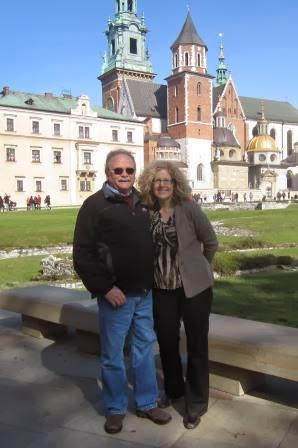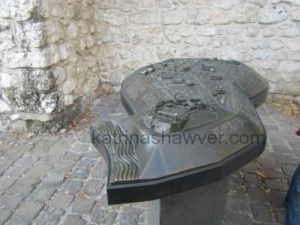 Wawel Castle (pronounced “VAH-vel”) which sits atop Wawel Hill is the most visited site in Poland – at least according to Rick Steves. Much of it is restored and available to walk through. You can walk the grounds for free or choose to tour a specific section of the castle – there are eight different tours, each about 15-30 minutes long. I think of it as sort of a castle buffet.
Wawel Castle (pronounced “VAH-vel”) which sits atop Wawel Hill is the most visited site in Poland – at least according to Rick Steves. Much of it is restored and available to walk through. You can walk the grounds for free or choose to tour a specific section of the castle – there are eight different tours, each about 15-30 minutes long. I think of it as sort of a castle buffet.
One afternoon we arrived late so only had time for one tour – so we visited the State Rooms. Then another day we had some more time in the morning so we did two tours. The first was the armory and treasury tour – think weapons, cannons and suits of armor. While none are original to the castle, it’s all time period relevant. In fact I saw my first cross-bow (weapons expert I am not.)
The Louvre has the Mona Lisa, but Poland has an earlier and better preserved portrait by Leonardo da Vinci – Lady with an Ermine, painted in approximately 1490. Currently it’s on display at Wawel Castle. Knowing Rick’s love of art I offered to do this tour alone – but he came along rather than get separated. We were both pleased for different reasons: for Rick it was a one-painting art exhibit – and now I can say I’ve seen a work by Leonardo da Vinci in person.
The painting dates to sometime around 1490 and is on wood. It was painted before the Mona Lisa and is significant for the artist’s use of light, the offset position of the model, and the fact you can see absolutely no brush strokes. It is one of Leonardo’s best preserved pictures and one of only four portaits of ladies done by da Vinci. It is only 21 x 15 inches in size but stunning in person. The background story is interesting – historians believe the subject is a well-known mistress of a duke; the white animal is a sign of purity.
The painting has changed hands many times through the years. Ironically even though Hitler looted Poland’s art and took it back to Germany, Hans Frank, the (Nazi) governor general of occupied Poland liked Wawel Castle (and its art) so much he established his headquarters at Wawel. Hans Frank found a way to get it back to Wawel and it hung in his residence during the war. As devastating as WWII was to the humans of Krakow – the Nazis were not going to bomb their own headquarters so Krakow (and Wawel) survived relatively intact.
 Not mentioned in guide books, but something I find interesting is a secondary public art form. Next to the main sights in historic Krakow, the city has erected detailed miniature versions, including inside Wawel Castle. These cast metal displays have signage in Braille as well as other languages; somewhere on the display there will be a small metal peg the size of a human – so without being able to see, a vision-impaired person might perceive the size of the structure. Anyone is encouraged to touch these miniature creations.
Not mentioned in guide books, but something I find interesting is a secondary public art form. Next to the main sights in historic Krakow, the city has erected detailed miniature versions, including inside Wawel Castle. These cast metal displays have signage in Braille as well as other languages; somewhere on the display there will be a small metal peg the size of a human – so without being able to see, a vision-impaired person might perceive the size of the structure. Anyone is encouraged to touch these miniature creations. (Photo of portrait downloaded from Wikipedia.)



